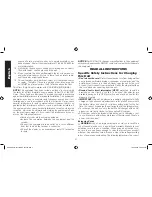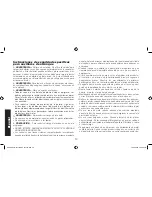
English
16
to chassis), replace steps 4a and 4b above with steps 5a and 5b,
then proceed to step 6.
5a. Connect negative (–) black clamp to vehicle battery’s negative
terminal.
5b. Connect positive (+) red clamp to vehicle chassis or a solid,
non-moving, metal vehicle component or body part. Never
clamp directly to positive battery terminal or moving part. Refer
to the automobile owner’s manual.
6. When the clamps are connected properly, the backlit LCD screen
will display the following to indicate the unit is ready to jump-start:
The Battery Status icon, Battery Voltage Indicator, Clamp Icons
and the “+” and”–” signs light solid. The jump starter icon will flash
to indicate the clamps are properly connected.
7. Turn the Jump-Starter Power Switch on. When the Jump-Starter
Power Switch is turned on, the Engine Icon lights solid indicating
it is time to start the vehicle. Turn on the ignition and crank the
engine in 5-6 second bursts until engine starts. The backlit LCD
screen will display the following:
The Battery Status Icon, the Battery Voltage Indicator, Jump Starter
Icon, Clamp Icons and the “+” and”–” signs light solid to indicate
the unit is jump-starting.
8. Turn the Jump-Starter Power Switch off.
9. Disconnect the negative (–) engine or chassis clamp first, then
disconnect the positive (+) battery clamp.
IMPORTANT:
Always turn the unit off when not in use. Recharge this
unit fully after each use.
CAUTION
– To reduce the risk of property damage:
•
Vehicles that have on-board computerized systems may be damaged
if vehicle battery is jump-started. Before jump-starting this type of
vehicle, read the vehicle manual to confirm that external-starting
assistance is advised.
•
Excessive engine cranking can damage the vehicle‘s starter motor. If
the engine fails to start after the recommended number of attempts,
discontinue jump-start procedure and look for other problems that
need to be corrected.
•
If vehicle fails to start, turn off the ignition, turn off the Jump-Starter
Power Switch, disconnect the jump-start system’s leads and contact
a qualified technician to investigate why the engine did not start.
Alternator Check
Set up the unit, connect the battery clamps and connect to the battery
following the directions in “Attaching the Clamps to the Unit” and steps
1 through 5 under “Procedure” in the “Jump-Starter” section.
Important Notes About the Alternator Check Function
1. The unit may detect that the alternator is out of typical voltage
range because someone has added a number of accessory loads
on the charging system, thereby increasing current demand from
the alternator. MAKE SURE THAT THE ALTERNATOR IS RATED
TO SUPPORT THE APPLICATION.
DXAEPS2_ManualENSP_101216.indd 16
10/19/2016 3:56:34 PM
















































